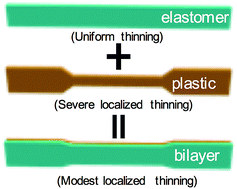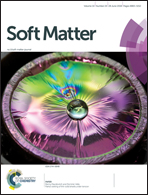Necking and drawing of rubber–plastic bilayer laminates†
Abstract
We examine the stretching behavior of rubber–plastic composites composed of a layer of styrene–ethylene/propylene–styrene (SEPS) rubber, bonded to a layer of linear low density polyethylene (LLDPE) plastic. Dog-bone shaped samples of rubber, plastic, and rubber–plastic bilayers with rubber : plastic thickness ratio in the range of 1.2–9 were subjected to uniaxial tension tests. The degree of inhomogeneity of deformation was quantified by digital image correlation analysis of video recordings of these tests. In tension, the SEPS layer showed homogeneous deformation, whereas the LLDPE layer showed necking followed by stable drawing owing to its elastoplastic deformation behavior and post-yield strain hardening. Bilayer laminates showed behavior intermediate between the plastic and the rubber, with the degree of necking and drawing reducing as the rubber : plastic ratio increased. A simple model was developed in which the force in the bilayer was taken as the sum of forces in the plastic and the rubber layers measured independently. By applying a mechanical energy balance to this model, the changes in bilayer necking behavior with rubber thickness could be predicted qualitatively.



 Please wait while we load your content...
Please wait while we load your content...